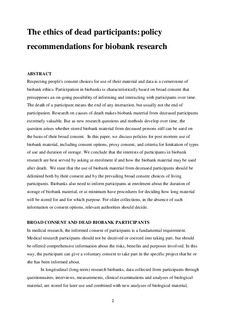| dc.contributor.author | Ursin, Lars | |
| dc.contributor.author | Stuifbergen, Maria C | |
| dc.date.accessioned | 2019-04-04T13:35:55Z | |
| dc.date.available | 2019-04-04T13:35:55Z | |
| dc.date.created | 2018-05-30T11:06:17Z | |
| dc.date.issued | 2018 | |
| dc.identifier.issn | 0306-6800 | |
| dc.identifier.uri | http://hdl.handle.net/11250/2593370 | |
| dc.description.abstract | Respecting people’s consent choices for use of their material and data is a cornerstone of biobank ethics. Participation in biobanks is characteristically based on broad consent that presupposes an ongoing possibility of informing and interacting with participants over time. The death of a participant means the end of any interaction, but usually not the end of participation. Research on causes of death makes biobank material from deceased participants extremely valuable. But as new research questions and methods develop over time, the question arises whether stored biobank material from deceased persons still can be used on the basis of their broad consent. In this paper, we discuss policies for postmortem use of biobank material, including consent options, proxy consent and criteria for limitation of types of use and duration of storage. We conclude that the interests of participants in biobank research are best served by asking at enrolment if and how the biobank material may be used after death. We state that the use of biobank material from deceased participants should be delimited both by their consent and by the prevailing broad consent choices of living participants.
Biobanks also need to inform participants at enrolment about the duration of storage of biobank material or at minimum have procedures for deciding how long material will be stored for and for which purpose. For older collections, in the absence of such information or consent options, relevant authorities should decide. | nb_NO |
| dc.language.iso | eng | nb_NO |
| dc.publisher | BMJ Publishing Group | nb_NO |
| dc.title | The ethics of dead participants: policy recommendations for biobank research | nb_NO |
| dc.type | Journal article | nb_NO |
| dc.type | Peer reviewed | nb_NO |
| dc.description.version | acceptedVersion | nb_NO |
| dc.source.journal | Journal of Medical Ethics | nb_NO |
| dc.identifier.doi | 10.1136/medethics-2017-104241 | |
| dc.identifier.cristin | 1587627 | |
| dc.description.localcode | © Article author(s) (or their employer(s) unless otherwise stated in the text of the article) 2018. All rights reserved. No commercial use is permitted unless otherwise expressly granted. Locked until 25.9.2019 due to copyright restrictions. The final authenticated version is available online at: http://dx.doi.org/10.1136/medethics-2017-104241 | nb_NO |
| cristin.unitcode | 194,65,20,0 | |
| cristin.unitcode | 194,65,20,15 | |
| cristin.unitname | Institutt for samfunnsmedisin og sykepleie | |
| cristin.unitname | Helseundersøkelsen i Nord-Trøndelag | |
| cristin.ispublished | true | |
| cristin.fulltext | postprint | |
| cristin.qualitycode | 2 | |
